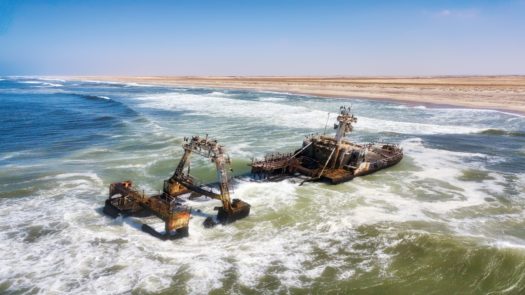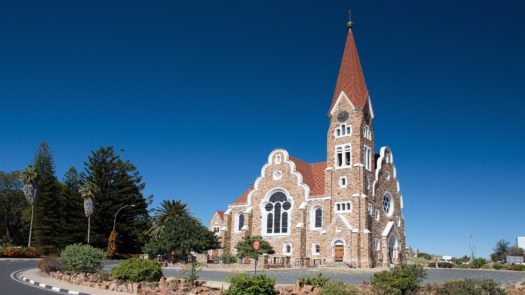Published on: December 7th, 2021
Last updated: April 19th, 2024
Namibia may not be the world’s most well-known destination, but that only adds to its appeal. This fascinating country on the southwestern edge of Africa is bursting with natural wonders, historic sites, incredible wildlife and so much more. It’s the perfect destination for adventurous explorers who are ready to get off the beaten path – and then go farther.
Why Visit Namibia?
Namibia is filled with innumerable sights to see. Its otherworldly landscapes consist of sweeping dunes, dramatic views and unspoiled nature. Home to a rich population of cheetahs, Namibia offers matchless wildlife viewing. It is a destination that is great to visit all year round.
1. Surreal Landscapes
Imagine an endless sea of copper sand dunes, punctuated by bright green blooms of life. Picture an otherworldly desert where the skeletons of abandoned ships sink into the sand. This may sound like a film set, but it’s nothing out of the norm in Namibia.
Few places on earth offer such a sheer variety of landscapes. The Namib Desert is home to Sossusvlei, with its rippling dunes and cracked clay valleys. Etosha National Park ranges from vast savannahs to silver salt pans, earning its reputation as ‘the place of mirages’. And that’s just the beginning…
2. Desert Wildlife
Namibia boasts the world’s oldest desert (the Namib) where you’ll find species that have adapted to life in this extremely dry environment. In its waterless riverbeds, you might spot a Hartmann’s zebra. Springbok and gemsbok are more common; they can go for long stretches of time without water, staying hydrated by eating shrubs and succulents.
Namibia’s desert elephants have also evolved to thrive in this climate. They use plants as water sources, have larger feet for trekking through sand and live in smaller herds than other elephants, which helps to conserve resources. If you want to see as many of these animals as possible, June–October is the best time to visit Namibia.
3. Eerie Shipwrecks
We already mentioned the aptly named Skeleton Coast: a desolate stretch of striking – if ominous – beauty on the northwestern side of Namibia. Over the centuries, countless ships have fallen victim to its strong currents and dangerous shores.
The result is a sandy graveyard, where the remains of those vessels speckle the landscape alongside secret rivers and shifting dunes – not to mention a world-famous surf break. If you’re traveling to Namibia, the Skeleton Coast is a mandatory stop.
4. Ghost Towns
Speaking of spooky sites, the Skeleton Coast is also where you’ll find the abandoned town of Kolmanskop. In the early 1900s, diamonds were discovered in the sand here. Before long, the town was full of German settlers seeking an easy fortune. But within a few decades, there were no more diamonds left… and Kolmanskop was abruptly abandoned.
Now the town is full of the shadows of its past. The stately German architecture has turned into fading ruins, and the empty houses are filled with waves of sand. Other outposts, like Oranjemund, faced a similar fate.
5. Remote Escapes
When you’re craving wide open spaces, there’s nowhere quite like Namibia. The country has an average of three people per square kilometre (the UK has about 94 times that, for reference). And certain areas are even less populated, like Kaokoland.
Kaokoland is home to the Himba and Herero groups, but don’t be surprised if you go hours without seeing another human. In our opinion, one of the best things to do in Namibia is to simply enjoy the peaceful isolation of its most remote regions.
6. Indigenous Culture
Namibia’s human history is about as old as it gets. The first humans are thought to have lived in the mountainous regions of south Namibia and their direct descendants, the San, still live in Namibia. Traditionally the San way of life was semi-nomadic and, although they would hunt animals, survival focused around finding and conserving water and edible plants.
The country has a wealth of cultural diversity. There are six different indigenous groups in Namibia, each with their own traditions, languages and lifestyles. This includes the Himba who are the custodians of the land in the Kunene Region. Here, there are opportunities to learn about their way of life, directly from the community itself.
7. Starry Skies
When we say Namibia is one of the best places on earth for stargazing, we mean it. This country has some of the world’s darkest skies, thanks to its clear weather and low light pollution. In fact, the NamibRand Nature Reserve has been named an International Dark Sky Reserve.
To fully appreciate it, take advantage of Sossusvlei Desert Lodge’s star-viewing skylights, advanced telescope and on-site observatory. If you’re planning a honeymoon in Namibia, we highly recommend this romantic destination.
8. Historical Wonders
Namibia is full of prehistoric sites and archaeological finds. Take, for example, Twyfelfontein: an open-air gallery of rock art with more than 2,000 engravings that date back several thousand years. They were likely created by San shamans, and feature all kinds of animals, human figures and even footprints.
But Twyfelfontein is by no means the only historical site to see in Namibia. You can also visit the famous Apollo 11 cave, the ancient Mirabib Rock or the fossilised dinosaur footprints at the Otjihaenamaparero Farm.
9. Unique Architecture
As you explore Namibia, you might notice that many of the buildings look more like they belong in northern Europe than in southern Africa. This is due to a legacy of German colonialism, which is especially obvious in the capital city of Windhoek.
Outside of the main cities, you’ll also get to see the traditional architecture of groups like the Himba, who use branches and cow dung to construct sturdy huts. Many luxury lodges are inspired by local building techniques and materials. On the Kunene River, Serra Cafema is even laid out in the structure of a Himba village – it’s one of our favourite places to stay on a luxury trip to Namibia.
10. Positive Impact on Communities
The best travel experiences benefit not only us – the travellers – but also the people who live in the places we visit. That’s why we’ll recommend camps that support communities, whether this be through employment opportunities or direct help in the community itself. And, we’ll be sure to point out the activities that not only protect the environment, but the people who live it.
For example, the land that Wilderness Serra Cafema Camp occupies has been shared with the camp by Himba people. In return, Wilderness, after listening to the needs of the community, runs educational programs, a mobile medical clinic and gives nutritional aid when needed.
11. Wildlife Protection
Here, environmental conservation isn’t just a nice idea; it’s actually written into the constitution. Namibia was the first country in Africa to do this, and the results are astounding. By helping local communities to protect wildlife through communal conservancies, they’ve managed to restore the populations of several endangered species.
We’re proud to work with these conservancies to promote conservation and sustainable tourism. These initiatives are vital to preserving the majesty of Namibia and making it accessible to travellers – while keeping its natural beauty, diversity and character intact.
Embark on your Namibian adventure
Namibia offers myriad opportunities for adventure, taking you from the wild, desolate landscapes and coastlines to some of Africa’s most wildlife-rich plains.




















